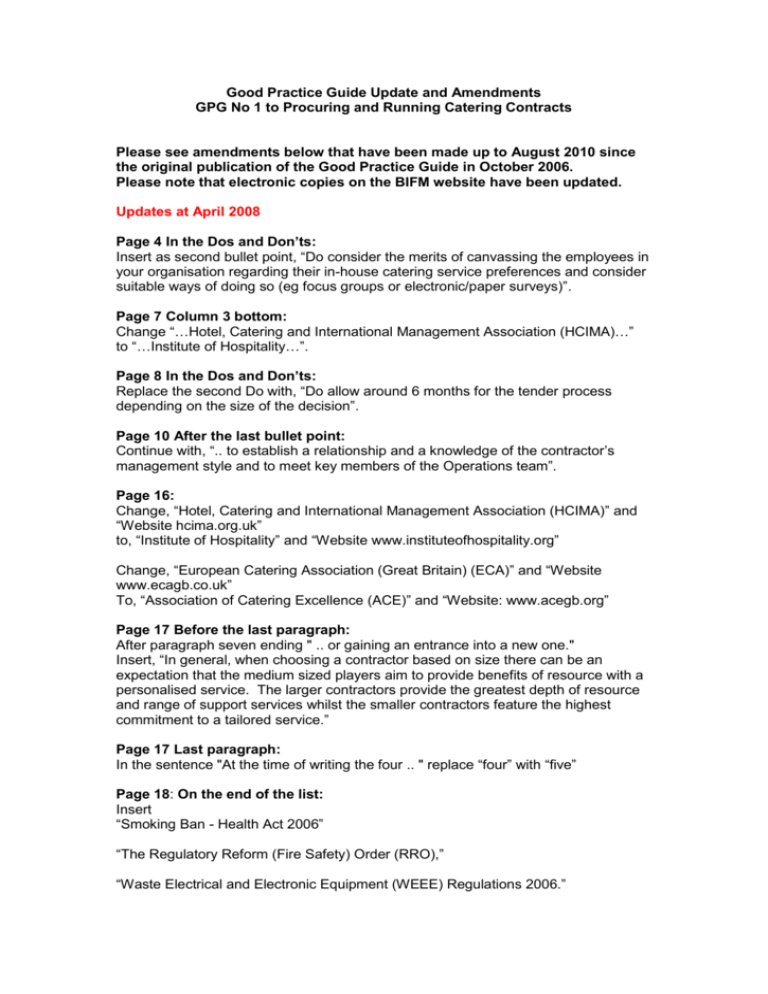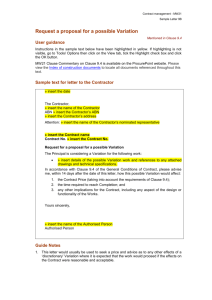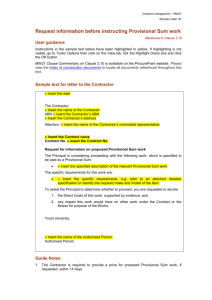GPG to Procuring and Running Catering Contracts
advertisement

Good Practice Guide Update and Amendments GPG No 1 to Procuring and Running Catering Contracts Please see amendments below that have been made up to August 2010 since the original publication of the Good Practice Guide in October 2006. Please note that electronic copies on the BIFM website have been updated. Updates at April 2008 Page 4 In the Dos and Don’ts: Insert as second bullet point, “Do consider the merits of canvassing the employees in your organisation regarding their in-house catering service preferences and consider suitable ways of doing so (eg focus groups or electronic/paper surveys)”. Page 7 Column 3 bottom: Change “…Hotel, Catering and International Management Association (HCIMA)…” to “…Institute of Hospitality…”. Page 8 In the Dos and Don’ts: Replace the second Do with, “Do allow around 6 months for the tender process depending on the size of the decision”. Page 10 After the last bullet point: Continue with, “.. to establish a relationship and a knowledge of the contractor’s management style and to meet key members of the Operations team”. Page 16: Change, “Hotel, Catering and International Management Association (HCIMA)” and “Website hcima.org.uk” to, “Institute of Hospitality” and “Website www.instituteofhospitality.org” Change, “European Catering Association (Great Britain) (ECA)” and “Website www.ecagb.co.uk” To, “Association of Catering Excellence (ACE)” and “Website: www.acegb.org” Page 17 Before the last paragraph: After paragraph seven ending " .. or gaining an entrance into a new one." Insert, “In general, when choosing a contractor based on size there can be an expectation that the medium sized players aim to provide benefits of resource with a personalised service. The larger contractors provide the greatest depth of resource and range of support services whilst the smaller contractors feature the highest commitment to a tailored service.” Page 17 Last paragraph: In the sentence "At the time of writing the four .. " replace “four” with “five” Page 18: On the end of the list: Insert “Smoking Ban - Health Act 2006” “The Regulatory Reform (Fire Safety) Order (RRO),” “Waste Electrical and Electronic Equipment (WEEE) Regulations 2006.” Page 19: Under Contractor’s responsibilities: Insert as the last bullet point under “other, “Ascertain who owns the stock – the contractor or the client? With a change of contractor the stock is either sold to the new incumbent or taken on by the client.” Page 19 Under Client’s responsibilities: Insert two last bullet points under “other” “ Access and security protection and protocol Correct acceptance of delivery of the goods if delivery bay is distanced from the kitchen” Updates at August 2010 Page 2 Immediately before the section heading ‘Hospitality’: Insert the following section “High street brands There are two possible approaches. Concession: A high street brand may agree to be introduced to the workplace sales opportunity in exchange for paying the company a % of sales made on a monthly basis. Franchise: A high Street brand may agree to allow its name to be used in the workplace and charge the company an introductory fee as well as a % of the sales made on a monthly basis.” Page 5 column 2: Replace the paragraph starting ‘As the name suggests …‘ with “As the name suggests, net into unit purchasing is when produce is invoiced at catering-site level at the price directly negotiated between the contractor and the supplier with no further discounts applicable.” Page 7 after the section headed ‘Nil subsidy’: Add two new sections “Guaranteed Cost This typically is similar to a fixed price and nil subsidy contract, the key difference being that where the contractor underspends against budget (or in the case of a nil subsidy contract actually generates a net profit), this is shared with the client company using a pre-agreed formula. As with fixed price/nil subsidy contracts, any overspends against budget remain the responsibility of the contractor. Commercial Contract This type of contract is typically seen in locations where the contractor is able to market their services to a wider potential clientele than simply those personnel working on the site. Therefore these sites are most often public-facing. They are very often seen at venues where the main business is events and functions which are marketed either directly by the caterer or in conjunction with the client company. In addition to direct catering costs, very often accommodation costs are also applied to the account in order to drive out the contract’s true profitability. Once the financial deal has been agreed, the caterer would pay the client a percentage of sales, meaning that the client needs to have only limited interest in the profitability of the contract.” Page 8 in Dos and Don’ts box: Change the second ‘DO’ from ‘Do allow around six months for the tender process depending on the size of the decision’ to ‘Do allow around four months for the tender process depending on the size of the decision’ Page 9 Top Table: Replace “Please propose a tariff that will recover the cost of food, VAT and 30% gross profit” with “Typical current net daily takings are £… and the typical number of personnel making use of the service is…. For the purposes of the tender, the current tariff should be assumed to continue. Please show what, if any, gross profit you will achieve based on this tariff” Page 13 column 2: First bullet point Replace HCIMA by IOH Page 16 column 1: Beside ‘Institute of Hospitality’ insert (IOH) Page 18 column 1: Remove “The Food Safety (General Food Hygiene) regulations 1995” and insert “The Food Safety Act 1990 (as amended) The General Food Law regulation (EC) 178/2002. The General Food Law regulation 2004 (as amended)” Page 20 column 2: Replace “Contractor to invest in required capital and depreciate over three or five years” with “Contractor to invest in required capital and depreciate over three, five or ten years” Update made: August 2010 Date of original publication: October 2006






